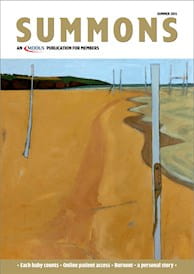OVER 2,000 new cases of testicular cancer are diagnosed in the UK every year. The majority of these occur in men aged between 15 and 45, making it the commonest tumour in this age group. However, 25 per cent of cases occur in men over the age of 45 and 6 per cent in men over the age of 60. Germ cell tumours, seminomas and teratomas are common in the younger age group; in older patients the diagnosis of a lymphoma should be considered.
Whereas 50 years ago most of the germ cell tumours proved fatal, advances in chemotherapy since 1970 have resulted in overall cure rates of 95 per cent, rising to 99 per cent for patients with stage 1 disease. Given the potential for some tumours to grow quickly, early diagnosis and referral is therefore important in maintaining this success.
Presentation
Men with testicular cancer commonly present having noticed either a painless swelling or enlargement of the whole testicle. A history of trauma is present in about 10 per cent of cases – where this has happened it is important to realise that it is usually the injury that has brought the swelling to the patient’s attention rather than the swelling being the result of the trauma. Occasionally, with hormone-producing tumours, patients present with gynaecomastia.
Testicular cancer is not usually painful but is associated with some discomfort in about 20 per cent of cases – often this is a dragging sensation due to its increased weight. If the testis is obviously painful and/or tender it may be due to epididymoorchitis, but the possibility of a testicular torsion must also be considered. Where there is any doubt the patient should be referred to hospital as an emergency.
A few men present with symptoms due to metastatic disease. General malaise or back pain may occur, as well as a mass in the neck due to enlargement of supraclavicular lymph nodes. The risk of developing testis cancer is increased if there is a history of an undescended testis, infertility (especially with a small testis) or a first-degree relative with the disease.
Clinical examination
It is important to note that over 95 per cent of men presenting with testicular swellings have benign disease. The common differential diagnoses include hydrocele, epididymal cyst and varicocoele. Most of these can be distinguished from a tumour by accurate clinical examination, noting particularly the anatomical of the swelling to the body of the testis and whether the swelling transilluminates. Tumours are always within the body of the testis so if a swelling can be separated from the body it is almost certainly benign.
Comparison with the normal side is useful, noting particularly differences in the size, shape and consistency of the testes, any of which may indicate malignancy. In particular, the presence of a small testis should not automatically be assumed to be due to atrophy as it may simply reflect abnormal enlargement of the contralateral testis or, if the small testis itself is abnormally firm, a tumour in a previously atrophic organ.
A swelling that transilluminates is likely to be a hydrocoele but in some men this may be associated with the presence of a tumour – it is therefore important for the clinician to confirm that the body of the testis itself feels normal. Where there is any doubt, an urgent ultrasound scan should be arranged.
As described above, metastatic testicular cancer forms part of the differential diagnosis of neck, especially supraclavicular, swellings and gynaecomastia. In either of these scenarios examination of the genitalia is essential.
Investigation
In experienced hands, the diagnosis of a tumour can usually be made by clinical examination alone but in the primary care setting the clinician needs to be confident that a tumour has been excluded. If there is any doubt, an urgent scrotal ultrasound scan should be arranged or the patient should be referred under the two-week rule for suspected cancers. Ultrasound is usually diagnostic but there are a small number of lesions which remain equivocal even when Doppler studies are included. In addition, ultrasound has a small false-positive rate with some benign conditions (e.g. epidermoid tumours, infarction) capable of mimicking cancers. If the scan shows a tumour or if it is inconclusive, an urgent referral to the local urology department is mandatory, again under the two-week pathway.
Serum α-fetoprotein (αFP) and β- Human chorionic gonadotrophin (βHCG) levels are valuable markers for germ cell tumours, being elevated in 50-70 per cent of patients. These markers can provide useful prognostic information and must be measured wherever there is a suspicion of a tumour. In the case of uncertainty, raised marker levels may also aid diagnosis.
Management
Where the ultrasound scan leaves doubt about the nature of a testicular abnormality and the tumour markers are normal, it is reasonable for a urologist to monitor a lesion by arranging a further ultrasound in 6-8 weeks’ time. However, before adopting this strategy the scans must be discussed and agreed in a multidisciplinary team (MDT) meeting. The outcome of this meeting should be clearly recorded in the patient’s notes, and both the patient and his GP should be informed. If the lesion remains stable, continued observation may be justified but any enlargement of the lesion requires that the testis be explored.
There are a small number of patients who present acutely ill with advanced, possibly life-threatening, metastatic disease. These patients should be referred immediately to an oncologist as they may require immediate chemotherapy before any treatment for the primary tumour. For the majority, however, radical inguinal orchiectomy is the treatment of choice.
Apart from the complications of infection and bleeding, patients should be warned of the small possibility that the testicular lesion may be benign – a scenario which frequently gives rise to litigation. At operation the spermatic cord is clamped at the internal ring and the testis delivered through the groin incision. Where there is a history of increased risk (e.g. small testis, maldescent) biopsy of the contralateral testis should be considered. The risk of postoperative pain can be reduced by taking care not to damage the ilioinguinal nerve during surgery. Postoperatively, αFP and βHCG levels should be re-measured – persistence of raised levels suggests the presence of distal disease.
In patients with only one testicle, if the lesion is small and tumour markers are normal it may be possible to perform a partial orchiectomy thus maintaining some hormone production and avoiding the need for testosterone replacement therapy.
All patients undergoing orchiectomy should be offered insertion of a testicular prosthesis as part of the same procedure. They should be informed that the prosthesis will provide only an approximate match to the remaining normal testis and that it may tend to ride high in the scrotum – this can be improved by gently manipulating the testis downwards daily in the postoperative period. They should also be warned of the risk of infection which could result in the prosthesis having to be removed.
As both the surgery and any subsequent treatments can impair fertility, patients should be offered sperm cryopreservation before orchiectomy, and they should also be informed that fertility rates using thawed sperm fall with increasing age of the female.
Following surgery all patients require CT scanning and then should be referred to the regional testicular cancer MDT meeting for consideration of adjuvant treatment.
Professor Krishna Sethia is a consultant urologist and medical director at Norfolk and Norwich University Hospitals and an honorary professor at the University of East Anglia
This page was correct at the time of publication. Any guidance is intended as general guidance for members only. If you are a member and need specific advice relating to your own circumstances, please contact one of our advisers.
Read more from this issue of Insight

Save this article
Save this article to a list of favourite articles which members can access in their account.
Save to library

